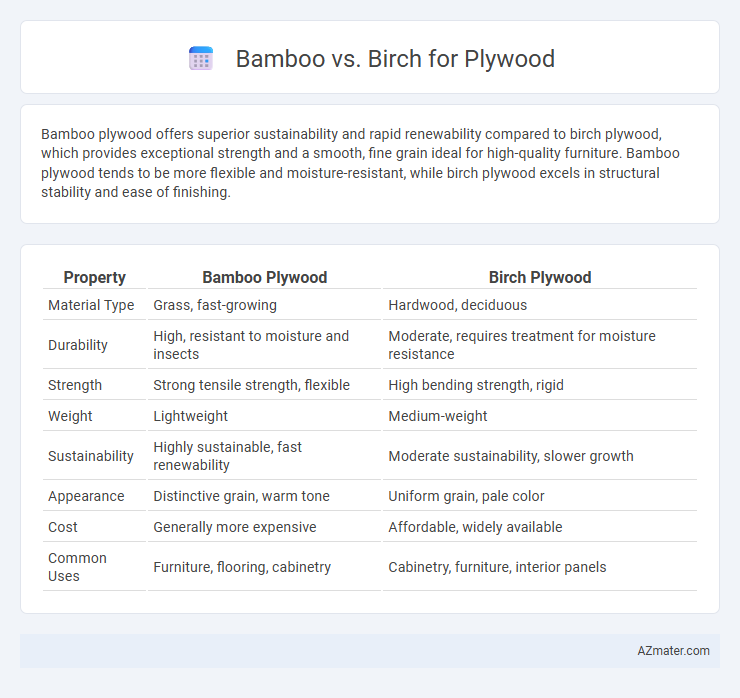Bamboo plywood offers superior sustainability and rapid renewability compared to birch plywood, which provides exceptional strength and a smooth, fine grain ideal for high-quality furniture. Bamboo plywood tends to be more flexible and moisture-resistant, while birch plywood excels in structural stability and ease of finishing.
Table of Comparison
| Property | Bamboo Plywood | Birch Plywood |
|---|---|---|
| Material Type | Grass, fast-growing | Hardwood, deciduous |
| Durability | High, resistant to moisture and insects | Moderate, requires treatment for moisture resistance |
| Strength | Strong tensile strength, flexible | High bending strength, rigid |
| Weight | Lightweight | Medium-weight |
| Sustainability | Highly sustainable, fast renewability | Moderate sustainability, slower growth |
| Appearance | Distinctive grain, warm tone | Uniform grain, pale color |
| Cost | Generally more expensive | Affordable, widely available |
| Common Uses | Furniture, flooring, cabinetry | Cabinetry, furniture, interior panels |
Introduction to Bamboo and Birch Plywood
Bamboo plywood is made from fast-growing bamboo grass, offering exceptional strength, flexibility, and sustainability due to its renewable harvesting cycle of 3-5 years. Birch plywood, derived from birch hardwood trees, provides a dense, durable surface with fine grain ideal for furniture and cabinetry. Both materials offer unique advantages in plywood applications, with bamboo emphasizing eco-friendliness and birch prized for its smooth finish and structural stability.
Material Origin and Sustainability
Bamboo plywood originates from fast-growing bamboo grass, characterized by its rapid renewability and carbon sequestration capacities, while birch plywood is derived from hardwood trees harvested from temperate forests, with growth cycles spanning several decades. Bamboo's cultivation requires fewer pesticides and water resources compared to traditional hardwood forestry, making it a more sustainable option in terms of environmental impact. Birch plywood, although more durable and denser, presents a higher ecological footprint due to longer growth periods and the intensiveness of forestry management practices.
Strength and Durability Comparison
Bamboo plywood exhibits remarkable tensile strength and resistance to impact due to its natural fibrous structure, making it highly durable for flooring and furniture applications. Birch plywood, known for its balanced strength and stiffness, offers excellent resistance to warping and splitting, ideal for cabinetry and interior paneling. Both materials provide durable options, with bamboo excelling in tensile resilience and birch delivering superior dimensional stability.
Environmental Impact and Eco-Friendliness
Bamboo plywood offers superior environmental benefits due to its rapid growth rate, absorbing more CO2 and regenerating quickly without the need for replanting, making it a highly renewable resource compared to birch plywood. Birch plywood, derived from slow-growing hardwood forests, has a larger carbon footprint and contributes more to deforestation and habitat disruption. Choosing bamboo plywood significantly reduces ecological impact while promoting sustainable forestry practices and biodiversity conservation.
Cost and Price Differences
Bamboo plywood generally costs more than birch plywood due to its faster renewability and increased demand in sustainable building materials. Birch plywood offers a more affordable option while maintaining strength and durability, making it a cost-effective choice for many woodworking projects. Price differences typically range from 10% to 30%, with bamboo commanding a premium for its eco-friendly appeal and unique grain patterns.
Workability and Ease of Use
Bamboo plywood offers superior workability due to its uniform grain and consistent density, allowing for precise cutting and minimal splintering. Birch plywood, known for its smooth surface and fine texture, is highly favored in woodworking for ease of sanding, gluing, and finishing. Both materials provide excellent versatility, but bamboo's rapid growth and stable structure make it slightly more resistant to warping during fabrication.
Appearance and Aesthetic Qualities
Bamboo plywood exhibits a distinctive striped grain pattern with warm golden hues, providing a modern and eco-friendly aesthetic ideal for contemporary interiors. Birch plywood features a consistent, fine-grain texture with light, creamy tones that offer a classic and versatile appearance suitable for traditional and minimalist designs. Both materials enhance spaces uniquely, with bamboo emphasizing sustainability and boldness, while birch emphasizes neutrality and refinement.
Moisture Resistance and Dimensional Stability
Bamboo plywood offers superior moisture resistance due to its dense, fibrous structure and natural silica content, making it less prone to swelling and warping compared to birch. Birch plywood is known for its good dimensional stability under normal conditions but tends to absorb moisture more readily, potentially leading to delamination and deformation in high-humidity environments. Choosing bamboo plywood is ideal for applications requiring enhanced durability against moisture and consistent shape retention over time.
Common Applications and Uses
Bamboo plywood is widely used in flooring, cabinetry, and furniture due to its high durability, sustainability, and natural resistance to moisture and pests. Birch plywood is commonly chosen for interior applications like shelving, cabinetry, and paneling because of its fine grain, smooth finish, and strength. Both materials excel in different environments, with bamboo favored for eco-friendly construction and birch preferred for decorative and structural purposes.
Choosing the Best Option: Bamboo vs Birch
Bamboo plywood offers exceptional sustainability and rapid renewability, making it an eco-friendly choice with high tensile strength and resistance to moisture, ideal for flooring and cabinetry. Birch plywood provides superior smoothness, uniform grain, and excellent paintability, offering durability and a clean appearance favored in furniture and interior construction. Selecting between bamboo and birch depends on the project's environmental priorities, structural requirements, and finish preferences, with bamboo excelling in green building and birch in aesthetic versatility.

Infographic: Bamboo vs Birch for Plywood
 azmater.com
azmater.com